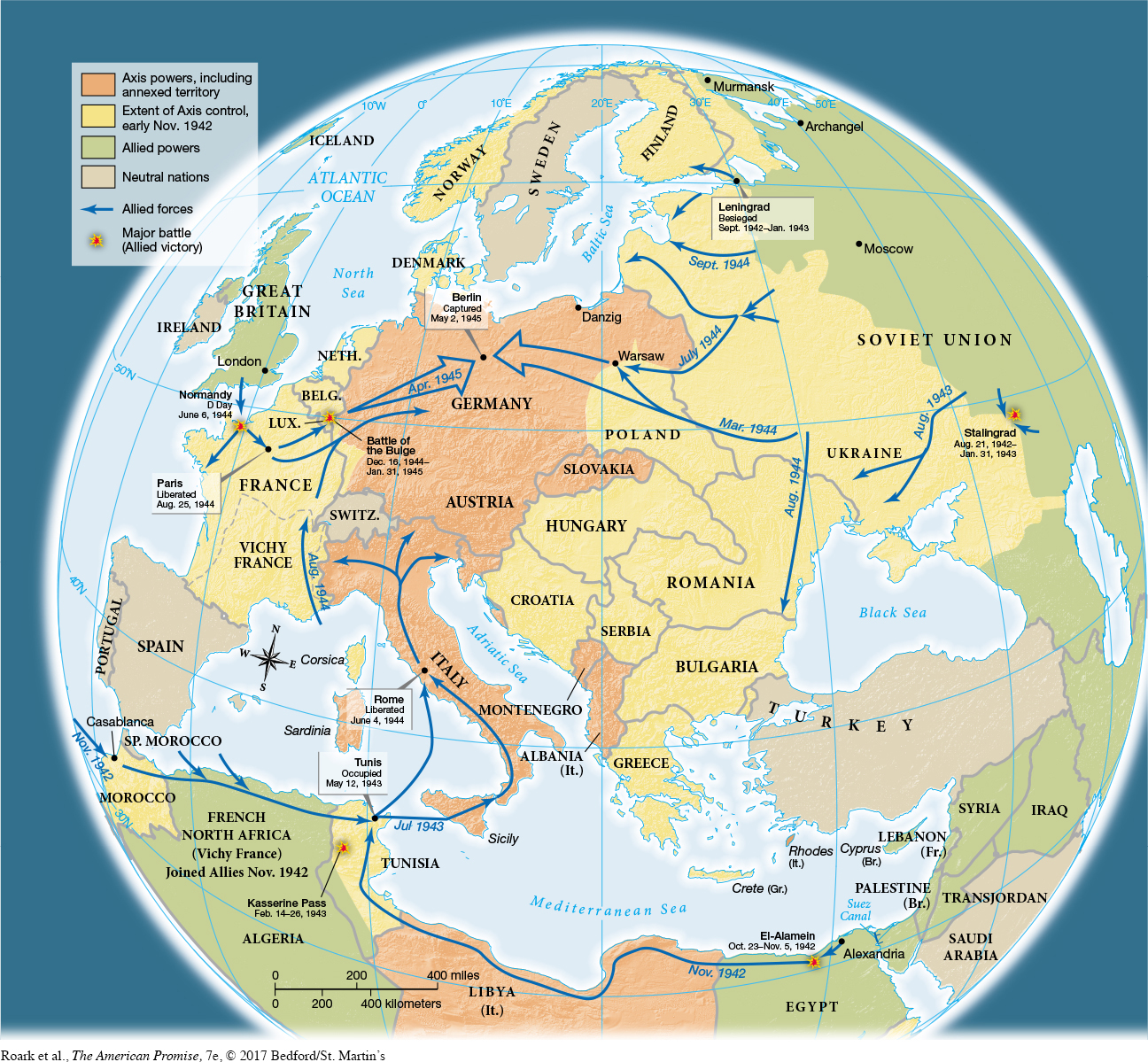The American Promise: Printed Page 734
The American Promise, Value Edition: Printed Page 667
The American Promise: A Concise History: Printed Page 763
From Bombing Raids to Berlin
While the Allied campaigns in North Africa and Italy were under way, British and American pilots flew bombing missions from England to German-
German air defenses took a fearsome toll on Allied pilots and aircraft. In 1943, two-
In November 1943, Churchill, Roosevelt, and Stalin met in Tehran to discuss wartime strategy and the second front. Roosevelt conceded to Stalin that the Soviet Union would exercise de facto control of the Eastern European countries that the Red Army occupied as it rolled back the still-
General Eisenhower was assigned overall command of Allied forces, and mountains of military supplies were stockpiled in England. The huge deployment of Hitler’s armies in the east, which were trying to halt the Red Army’s westward offensive, left too few German troops to stop the millions of Allied soldiers waiting to attack France. More decisive, years of Allied air raids had decimated the German Luftwaffe, which could send aloft only 300 fighter planes against 12,000 Allied aircraft.
After frustrating delays caused by stormy weather, Eisenhower launched the largest amphibious assault in world history on D Day, June 6, 1944 (Map 25.4). Allied soldiers finally succeeded in securing the beachhead. An officer told his men, “The only people on this beach are the dead and those that are going to die—

Within a week, a flood of soldiers, tanks, and other military equipment propelled Allied forces toward Germany. On August 25, the Allies liberated Paris from four years of Nazi occupation. As the giant pincers of the Allied and Soviet armies closed on Germany in December 1944, Hitler ordered a counterattack to capture the Allies’ essential supply port at Antwerp, Belgium. In the Battle of the Bulge (December 16, 1944, to January 31, 1945), as the Allies termed it, German forces drove fifty-
The American Promise: Printed Page 734
The American Promise, Value Edition: Printed Page 667
The American Promise: A Concise History: Printed Page 763
Page 735The American Promise: Printed Page 734
The American Promise, Value Edition: Printed Page 667
The American Promise: A Concise History: Printed Page 763
Page 736In February 1945, while Allied armies relentlessly pushed German forces backward, Churchill, Stalin, and Roosevelt met secretly at the Yalta Conference (named for the Russian resort town where it was held) to discuss their plans for the postwar world. Roosevelt managed to secure Stalin’s promise to permit votes of self-
The “Big Three” also agreed on the creation of a new international peacekeeping organization, the United Nations (UN). All nations would have a place in the UN General Assembly, but the Security Council would wield decisive power, and its permanent representatives from the Allied powers—
While Allied armies sped toward Berlin, Allied warplanes dropped more bombs after D Day than in all the previous European bombing raids combined. By April 11, Allied armies reached the banks of the Elbe River and paused while the Soviets smashed into Berlin. The Red Army captured Berlin on May 2. Hitler had committed suicide on April 30, and the provisional German government surrendered unconditionally on May 7. The war in Europe was finally over, with the sacrifice of 135,576 American soldiers, nearly 250,000 British troops, and 9 million Russian combatants. (See “Making Historical Arguments: Why Did the Allies Win World War II?”)
Roosevelt did not live to witness the end of the war. On April 12, he suffered a fatal stroke. Americans grieved for the man who had led them through years of depression and world war, and they worried about his untested successor, Vice President Harry Truman.